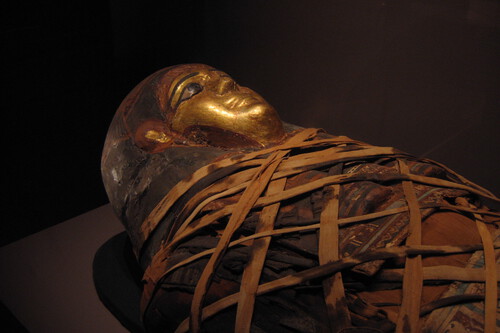Why are roses red? What’s the meaning of life? Should pizza have pineapple? And—what does a 5,000-year-old Egyptian mummy smell like? The answers to some of these questions aren’t clear (except for pineapple on pizza, of course). But if you’ve ever wondered about the aroma of ancient embalming, you’re not alone.
For months, a team of researchers has been analyzing the scents of mummies. Now, they want the world to experience them, too.
The fragrance of mummies. “We were surprised at the pleasantness of them,” Cecilia Bembibre, an expert in sustainable heritage, told BBC Radio 4 after the release of a University College London (UCL) study on the topic. It’s an unexpected revelation, considering these bodies have been sealed in sarcophagi for millennia. Movies, literature, and common sense would all suggest otherwise.
But when you think about it, the idea isn’t so far-fetched. Mummification aimed to preserve both body and soul for the afterlife. Just as the deceased were buried with valuables, their bodies were treated with oils and balms, meant to last for eternity.

A “sweet” surprise. Did the researchers simply open sarcophagi and take a deep breath? Thankfully, no—that would be both unsanitary and unreliable. Instead, teams from UCL and the University of Ljubljana in Slovenia used tiny tubes to extract gas samples from the tombs in a non-invasive way.

Identifying smells. Analyzing these scents is complex, but researchers describe them as intense yet surprisingly pleasant, with notes of wood, spices, and a subtle sweetness—far from the putrid decay we might expect. However, they also detected traces of decomposing animal fat, a key ingredient in embalming, revealing that even preserved bodies weren’t immune to time.
Rather than relying on human noses, the team used gas chromatography to separate the individual scent compounds. A program then analyzed these components, compared them to known odor markers, and reconstructed the original fragrances used in embalming.
 The researchers compared data from the nine mummies to see which markers matched familiar scents.
The researchers compared data from the nine mummies to see which markers matched familiar scents.
Why it matters. This research serves two major purposes. First, it helps conservators better preserve mummies. By understanding the specific substances used in mummification, museums can develop storage techniques that align more closely with ancient practices. Additionally, because embalming materials evolved over time, scent analysis could provide clues about a mummy’s age and historical context.
Second, scent is a powerful trigger for memory and emotion. Smells can transport us to different times and places in ways that visuals alone cannot. “It’s an innovative way of communicating history,” Ally Louks, head of English literature at Cambridge University, told the BBC.
Ali Abdelhalim, co-author of the study and director of the Egyptian Museum in Cairo, also noted that scent was deeply symbolic in ancient Egypt. Pleasant aromas were associated with deities and purity, while foul odors signified bodily corruption and decay.
A new way to experience history. The research team suggests this method could be used to enhance museum exhibits. Imagine walking into a gallery displaying ancient Egyptian artifacts—not only seeing a mummy but also experiencing the same scents used in its embalming process.
By decoding and recreating these ancient aromas, scientists aren’t only bringing us closer to history but also helping to preserve it for generations to come.
Image | Liz Lawley | UCL



